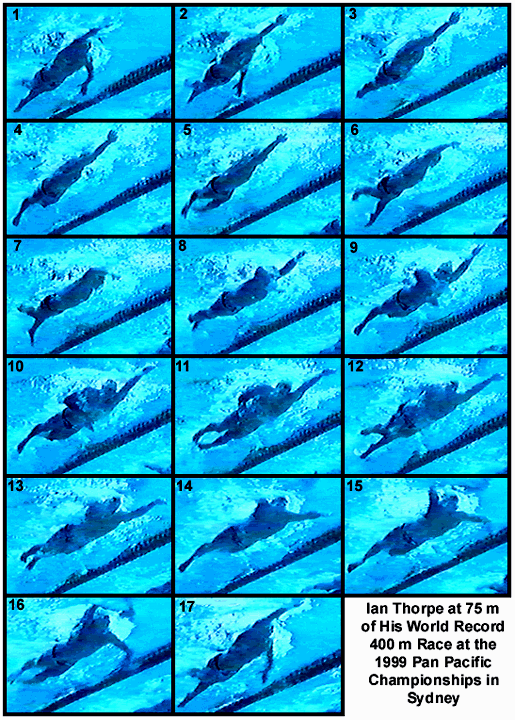HOW CHAMPIONS DO IT
Researched, produced, and prepared by Brent S. Rushall,
Ph.D., R.Psy.

IAN THORPE AT 75 m OF HIS WORLD RECORD 400 m RACE AT THE 1999 PAN PACIFIC CHAMPIONSHIPS IN SYDNEY
Each frame is .1 seconds apart. Ian Thorpe's time in this event was 3:41.83 a substantial improvement on the old world record for this distance.
Notable Features
There are only minor differences in technique between the form shown here at 75 m and the form exhibited at 375 m. The race was negatively split at 200 meters. During the race, the fifth lap was covered faster than most other 50-m sections as Ian Thorpe broke from the field.
The most obvious technique difference, and it is only a minor one, occurs with the effective propulsion phase of the left-arm pull. It starts earlier in the stroke than at 375 m. That earlier start also occurs with the recovering arm not as far through its phase as at the latter stage of the race.
The specifics of this action are described for the analysis at 375 m. However, the general features of this stroke are worthy of repeating here.
- The speed of recovery (approximately .5 seconds) is much shorter than the duration of either pull (1.1+ seconds for the right arm and 1.2 seconds for the left). This gives the illusion of an overtaking stroke. However, a more logical explanation is that it demonstrates the swimmer "parking" the inactive arm while the other completes its long and direct propulsion. The resistance incurred by the increased wetted surface is less detrimental than the resistances that would be caused by a slower recovery. This is also a characteristic of the other tall Australian distance swimmer, Grant Hackett.
- Ian Thorpe's body roll is different to that normally described. The position of maximum rotation is achieved at full stretch after entry and as the other hand exits. By the time propulsive forces become fully effective, the shoulders are relatively flat. That causes a lateral action as the upper arm pivots at the shoulder joint, which needs to be partly offset/corrected through a same-side leg movement (possibly a reduced kick). There is no "leaning" on the arm during its pull. Perhaps for men's distance-swimming and swimmers of this physical structure, streamlining and direct force propulsion are more important than body rotation.
- The directness of each arm's pull and the effective length of those pulls are the outstanding features of Ian Thorpe's stroke. His physique has caused a compromise between arm pull force and body rotation. His head action could be improved if rotation was to only occur about the longitudinal axis. The appearance of kick-domination could be improved. The extended hold of the right arm that requires two kicks would seem to be something worthy of consideration for correction and improvement. That "hold" contributes to a "bounce" or "surge" in the stroke.
- The above suggestions aside, Ian Thorpe demonstrates streamlining, effective force production, and effective stroke length that are worthy of emulation.

Return to Table of Contents for this section.




